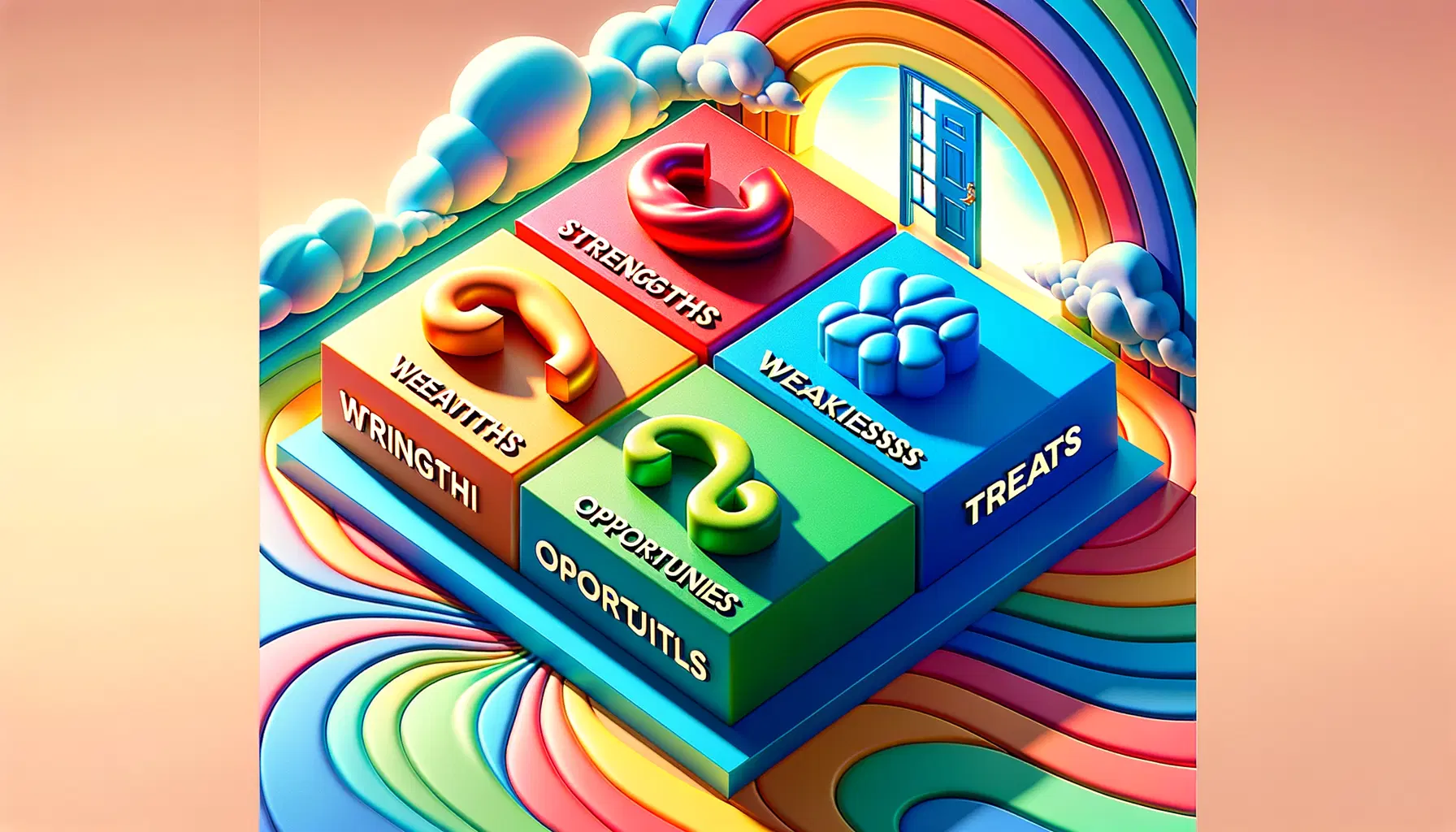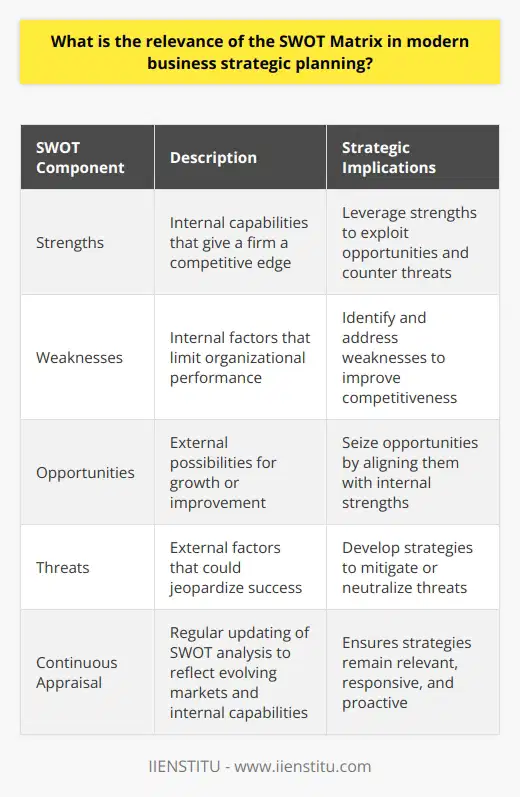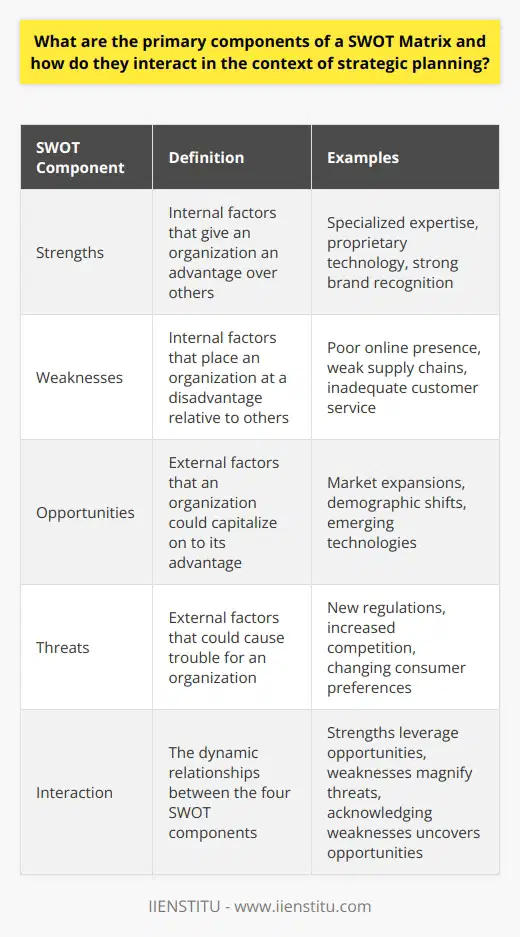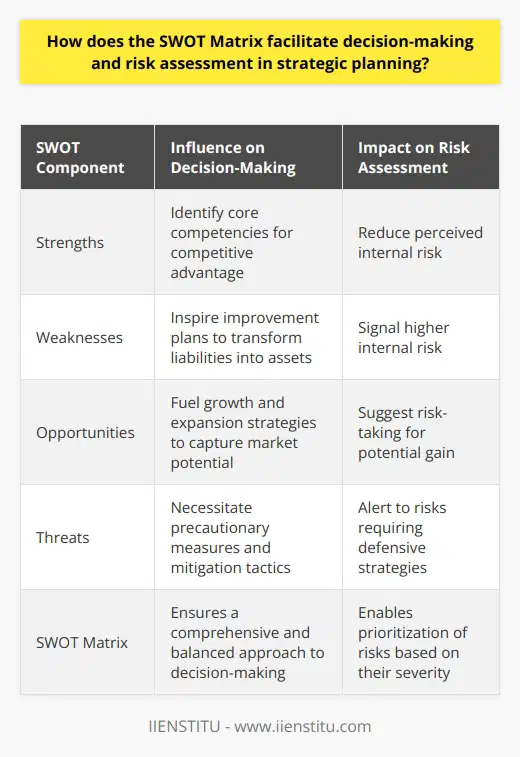
The SWOT Matrix, a powerful tool for strategic planning, helps organizations evaluate their internal and external factors to gain a competitive edge. By understanding the Strengths, Weaknesses, Opportunities, and Threats, companies can make informed decisions and plan for sustainable growth. This article will explore the SWOT Matrix in depth, providing insights and examples to help you effectively apply this framework to your organization.
Understanding the SWOT Matrix
The SWOT Matrix is a strategic planning tool that allows organizations to identify and categorize the key factors influencing their success. It provides a clear overview of the business landscape, enabling companies to make informed decisions and allocate resources effectively.
Components of the SWOT Matrix
The SWOT Matrix consists of four main components:
Strengths: Unique resources and capabilities that give the organization a competitive advantage.
Weaknesses: Areas where the organization lacks or is vulnerable compared to its competitors.
Opportunities: External factors and trends that the organization can capitalize on for growth.
Threats: Potential challenges from the business environment that could hinder progress or lead to failure.
Benefits of Using the SWOT Matrix
By employing the SWOT Matrix, organizations can:
Gain strategic awareness and preparedness
Identify their competitive edge and areas for improvement
Proactively address emerging trends and potential challenges
Optimize resource allocation for maximum impact
In-depth Analysis of the SWOT Matrix Components
Let's dive deeper into each component of the SWOT Matrix and explore how they contribute to strategic planning.
Strengths
Strengths are the foundation of an organization's competitive advantage. They define the unique value proposition that a business offers to its customers and stakeholders. Examples of strengths include:
Strong brand reputation
Innovative products or services
Efficient supply chain management
Skilled workforce
To identify strengths, organizations must be introspective and honest about what truly sets them apart from their competitors.
Weaknesses
Acknowledging weaknesses is crucial for continuous improvement. It requires a critical and objective assessment of the organization's operations to reveal genuine shortcomings. Examples of weaknesses include:
Limited financial resources
Outdated technology or infrastructure
Weak customer service
High employee turnover
By identifying weaknesses, organizations can take steps to address them and minimize their impact on overall performance.
Opportunities
Opportunities represent potential avenues for growth and expansion within the market or business environment. They can arise from various sources, such as:
Shifts in consumer preferences
Emerging technologies
Changes in regulations or policies
Untapped market segments
To seize opportunities, organizations must be proactive and agile in adapting to changing circumstances.
Threats
Threats are external challenges that can disrupt an organization's progress towards its goals. They can come from various sources, including:
New competitors entering the market
Substitute products or services
Economic downturns
Technological disruptions
By anticipating and preparing for potential threats, organizations can minimize their impact and maintain a competitive edge.
SWOT Matrix in Action: Real-World Examples
To better understand the practical application of the SWOT Matrix, let's explore some real-world examples across different industries.
Use of SWOT Matrix in the Retail Industry
Retail giants like Walmart use the SWOT Matrix to assess their strengths, such as efficient supply chain management, against the threats posed by e-commerce competitors like Amazon. By identifying opportunities in omnichannel retailing and addressing weaknesses in online presence, retailers can adapt to changing consumer behaviors and maintain their market position.
Application of SWOT Matrix in the Manufacturing Sector
In the manufacturing sector, companies like Toyota apply the SWOT Matrix to stay competitive in a challenging landscape. They may identify opportunities in the growing demand for eco-friendly vehicles and leverage their strengths in quality control and lean manufacturing to address weaknesses in production costs and adapt to the threat of new entrants in the market.
Utilization of SWOT Matrix in the Technology Industry
Technology companies, such as Google, use the SWOT Matrix to navigate the rapidly evolving industry landscape. They may recognize their strengths in data analytics and innovation, while acknowledging weaknesses in data privacy and security. By identifying opportunities in artificial intelligence and cloud computing, and preparing for threats like regulatory changes and intense competition, tech companies can stay ahead of the curve.
How to Generate a SWOT Matrix
Creating a SWOT Matrix involves a structured process of brainstorming and analysis. Here's a step-by-step guide to help you generate an effective SWOT Matrix for your organization:
Assemble a diverse team: Bring together individuals from different departments and levels of the organization to ensure a well-rounded perspective.
Brainstorm factors: Encourage open discussion and gather as many relevant factors as possible under each category (Strengths, Weaknesses, Opportunities, Threats).
Prioritize and refine: Review the list of factors and prioritize the most significant ones based on their potential impact on the organization.
Analyze and discuss: Engage in a deeper analysis of each factor, exploring their implications and potential strategies to address them.
Document and share: Organize the findings into a clear and concise SWOT Matrix document and share it with relevant stakeholders for feedback and input.
Use of Different Tools in Making the Matrix
Various tools and software can be used to create a SWOT Matrix, ranging from simple spreadsheets to specialized strategic planning platforms. These tools can help facilitate collaboration, organize information, and visualize the analysis. However, it's essential to remember that the tool should support the critical thinking process, not replace it.
Pointers on Writing an Effective SWOT Analysis
To create an effective SWOT analysis, keep the following tips in mind:
Be objective and evidence-based: Rely on data and facts rather than assumptions or opinions.
Make it actionable: Ensure that each factor identified in the matrix is something the organization can act upon.
Maintain balance: Give equal attention to all four components of the SWOT Matrix to avoid overemphasizing one aspect.
Keep it concise: Focus on the most critical factors and avoid getting bogged down in minor details.
Regularly update: Revisit and update the SWOT Matrix periodically to reflect changes in the business environment.
Conclusion
The SWOT Matrix is a powerful tool for strategic planning that has stood the test of time. By understanding and applying this framework, organizations can gain a competitive edge, make informed decisions, and plan for sustainable growth. Whether you're a small startup or a large corporation, the SWOT Matrix can help you navigate the complexities of the business world and achieve your goals.
Remember, the key to success with the SWOT Matrix is to be honest, objective, and proactive in your analysis. By embracing the insights gained from this process, you can position your organization for long-term success and resilience in the face of challenges.
So, gather your team, grab your favorite brainstorming tools, and start exploring the strengths, weaknesses, opportunities, and threats that shape your organization's future. With the SWOT Matrix as your guide, you'll be well on your way to strategic success.
Frequently Asked Questions
What is the relevance of the SWOT Matrix in modern business strategic planning?
Understanding the SWOT Matrix
The SWOT Matrix remains a cornerstone in business strategy formulation. Its simplicity belies its profound utility. Firms leverage the SWOT framework to dissect their competitive landscapes and internal competencies. The SWOT analysis compels organizations to introspect and scrutinize their external environments.
SWOT Composition and Strategic Influence
The matrix breaks down into four quadrants. Each signifies a unique aspect of business analysis. Strengths denote internal capabilities giving firms a competitive edge. Weaknesses are internal factors that limit organizational performance. Opportunities encompass external possibilities for growth or improvement. Threats reflect external factors that could jeopardize success.
This matrix guides strategic planning by aligning internal traits with external realities. It aids in crafting a strategy that exploits strengths and opportunities. It also mitigates weaknesses and threats.
SWOT in Contemporary Business Landscapes
Modern businesses function in dynamic environments. They require tools that are both flexible and holistic. The SWOT Matrix fits this need perfectly. It allows teams to pinpoint where a business excels, where it falters, its prospects, and its risks. Organizations adapt by acknowledging these elements and devising appropriate strategies.
Leaders must update their SWOT analyses regularly. Markets evolve, as do internal capabilities. Continuous SWOT appraisal ensures strategies remain relevant and responsive. It enables proactive rather than reactive planning.
Applications Beyond Corporate Strategy
SWOT extends past mere corporate strategizing. It applies to various business units, products, or even individual projects. Marketing teams use it to assess campaign effectiveness. HR applies it to workforce planning and development. Its flexibility makes it indispensable across departments.
Challenges and Considerations
Critics argue the SWOT Matrix lacks complexity. They say it cannot capture intricate business nuances. Yet, its real strength lies in its straightforwardness. It fosters clear thinking and communication. It acts as a foundation for more complex strategy models.
Firms may fall prey to incomplete analyses. Correct application of the SWOT Matrix requires comprehensive understanding. It demands input from diverse organizational areas. Collaboration across departments ensures a more accurate and effective analysis.
Teams must distinguish between perceived and real strengths or weaknesses. Bias or misjudgment can distort strategic plans. Objectivity drives the utility of SWOT.
In conclusion, the SWOT Matrix endures in strategic planning for a reason. It offers a direct and versatile approach to analyzing business potential. Its relevance stands undisputed as a starting point for informed decision-making. It harmonizes introspection with environmental awareness, fostering adaptable and robust business strategies.

What are the primary components of a SWOT Matrix and how do they interact in the context of strategic planning?
Understanding SWOT
The SWOT matrix forms a key part of strategic planning. It provides a straightforward framework. Analysts and managers rely on it frequently. To understand its primary components, let's delve deeper.
The Four Quadrants of SWOT
At its core, the SWOT matrix has four distinct quadrants. They interact dynamically. This interaction informs an organization's strategic direction.
Strengths and weaknesses represent internal factors. They are within an organization’s control. Strengths could include specialized expertise or proprietary technology. Weaknesses might be poor online presence or weak supply chains.
Opportunities and threats embody external factors. These lie outside of direct control. Opportunities can be market expansions or demographic shifts. Threats might include new regulations or increased competition.
The matrix demands a close examination of these elements. This examination highlights how one component may influence another.
Interaction within SWOT
Interactions within the SWOT matrix reveal complex relationships.
Strengths leverage opportunities. Effective use of strengths enables capitalization on opportunities. A robust R&D department, for example, can exploit emerging technologies.
Conversely, strengths mitigate threats. Strong brand recognition can off-set competitive challenges. The stronger the strengths, the less impact threats will likely have.
Weaknesses, when ignored, magnify threats. A weak online presence leaves a company vulnerable in a digital age.
However, acknowledging weaknesses can uncover opportunities. Identifying poor customer service can lead to enhanced training programs.
Each component does not operate in isolation. They provide a comprehensive view of the current strategic position.
Strategic Planning with SWOT
Strategic planning with SWOT requires a careful balance. It involves prioritizing actions based on the matrix's insights.
- Maximize strengths
- Address weaknesses
- Seize opportunities
- Minimize threats
Integration and balance are key. They ensure that strategies are well-rounded and robust.
SWOT analyses lead to informed decision-making. They guide companies through complex business landscapes. Moreover, SWOT promotes proactive rather than reactive strategies.
In closing, the interaction within the SWOT matrix guides strategic planning. It ensures that strategies are not developed in a vacuum. Rather, they consider a myriad of internal and external factors. This, in turn, leads to more successful business outcomes.

How does the SWOT Matrix facilitate decision-making and risk assessment in strategic planning?
Understanding the SWOT Matrix
The SWOT Matrix stands crucial in strategic planning. It dissects key elements. Companies use SWOT for internal and external assessment. Strengths and Weaknesses form the internal axis. Opportunities and Threats represent the external dimension. Clarity through SWOT influences decisions and risk evaluation.
Facilitation of Decision-Making
SWOT guides strategic choices. Decision-makers identify core competencies by considering strengths. They leverage these for competitive advantage. Weaknesses, when recognized, inspire improvement plans. These plans aim to transform liabilities into assets.
Opportunities fuel growth and expansion. They prompt strategies for capturing market potential. Threats necessitate precautionary measures. Firms devise mitigation tactics to cushion against market volatility. The SWOT Matrix compels a balanced view. It ensures a comprehensive approach to decision-making.
Risk Assessment in Strategic Planning
Risk assessment involves uncertainty appraisal. The SWOT Matrix aids in systematic risk identification. It highlights vulnerable areas inherent to the organization. It also pinpoints external risks that businesses might face.
- Strengths: Reduce perceived internal risk.
- Weaknesses: Signal higher internal risk.
- Opportunities: Suggest risk-taking for potential gain.
- Threats: Alert to risks requiring defensive strategies.
By categorizing risks, the matrix enables prioritization. High-risk areas demand more immediate action. Lower risks might allow for long-term planning. The SWOT Matrix encourages proactive rather than reactive planning.
Conclusion
The SWOT Matrix enriches strategic thinking. It makes decision-making more structured. It also ensures thorough risk assessment. By revealing multifaceted business perspectives, it supports informed strategy development. This ultimately leads to more resilient and adaptable organizations.



